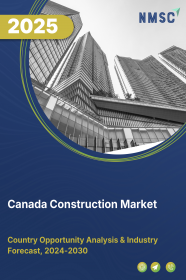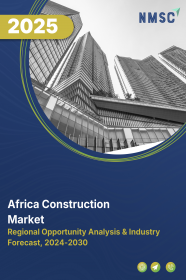
Canada Construction Market by Type (Renovation, and New Construction), Construction Method (Traditional, Prefabricated/Modular, 3D-Printed, and Green/Sustainable), Contractor Type (Large, Medium, and Small), and Sector (Real Estate (Residential [Affordable, and Luxury], Commercial [Retail, Office, and Others], Infrastructure [Transportation, and Others], Industrial [Manufacturing Plants, Warehouses, and Others])– Industry Trends and Forecast, 2025–2030
Industry: Construction & Manufacturing | Publish Date: 28-May-2025 | No of Pages: N/A | No. of Tables: N/A | No. of Figures: N/A | Format: PDF | Report Code : CM3361
US Tariff Impact on Canada Construction Market
Trump Tariffs Are Reshaping Global Business
Canada Construction Market Overview
The Canada Construction Market size was valued at USD 252.61 billion in 2024, and is predicted to reach USD 254.95 billion by the end of 2025. The industry is predicted to reach USD 402.35 billion by the end of 2030, at a CAGR of 9.6% from 2025 to 2030.
Canada construction market is experiencing robust growth, driven by strong government initiatives focused on improving housing, transportation, and sustainable infrastructure. This momentum is further supported by the execution of large-scale infrastructure megaprojects across provinces, aimed at enhancing energy, transit, and urban development. However, the sector continues to face challenges due to complex and inconsistent regulatory frameworks that delay project execution and elevate costs. At the same time, the adoption of digital technologies, particularly Building Information Modeling (BIM), is unlocking new growth opportunities by improving project efficiency, accuracy, and collaboration, signaling a transformative shift toward a more modernized construction industry.
Government Initiatives Propel Canada Construction Market Growth
The Canada construction market is witnessing significant growth, fueled by strong federal initiatives aimed at modernizing transportation networks, expanding housing infrastructure, and promoting sustainable development. In April 2024, the federal government launched the USD 4.4 billion Canada Housing Infrastructure Fund, targeting the construction of 750,000 new homes by 2033. This was complemented by an USD 11.1 billion top-up to the Apartment Construction Loan Program to facilitate the building of 30,000 new apartments. The Alto high-speed rail project, advancing in 2025 with a USD 15 billion investment, aims to connect Toronto to Quebec City with a 1,000-kilometer electrified line by 2035, boosting regional connectivity and economic activity. Additionally, the 2025 Budget allocated USD 3.2 billion for 180 infrastructure projects, including public transit enhancements and green energy initiatives, underlining Canada’s commitment to resilient and sustainable communities across both urban and rural regions.
Remarkable Expansion of Infrastructure Sector Boosts the Canada Construction Market
Canada’s construction market is also experiencing remarkable expansion driven by a surge in large-scale infrastructure megaprojects. In British Columbia, the USD 16 billion Site C Clean Energy Project a hydroelectric dam scheduled for completion by November 2025—will generate power for approximately 450,000 homes. Ontario’s GO Expansion On-Corridor Works, a USD 15.7 billion initiative, is upgrading rail infrastructure across the Greater Toronto-Hamilton Area, with major station improvements ongoing in 2024. Quebec’s USD 6.9 billion Réseau express métropolitain (REM) light rail network became largely operational in Montreal by 2024, with an airport link slated for completion by 2027. Additional transformative projects include the USD 13 billion Bruce Power Refurbishment, USD 12.8 billion Darlington Nuclear Refurbishment, USD 12.57 billion Eglinton Crosstown LRT, and USD 10.9 billion Ontario Line. These developments underscore Canada’s strategic focus on enhancing energy efficiency, modernizing transit systems, and fostering sustainable urban growth, collectively driving robust market expansion.
Regulatory Challenges Impede Canada Construction Market Growth
The construction industry continues to face growth barriers due to complex and evolving regulatory requirements. Projects require multiple approvals from different levels of government—local, regional, and national which involve compliance with zoning laws, environmental assessments, building codes, and safety standards. These multilayered permitting processes cause delays, increase project costs, and reduce investor confidence. Inconsistent regulations across jurisdictions and bureaucratic inefficiencies further extend project timelines. Additionally, unexpected changes in regulatory policies disrupt ongoing developments and stall progress.
Digitalization and BIM Adoption Unlock Growth Potential in Canada Construction Market Growth
The Canada construction market is rapidly evolving through the integration of digital tools and Building Information Modeling (BIM), creating new opportunities for improved efficiency and project delivery. BIM enables project teams to plan, design, and manage infrastructure digitally, which helps enhance accuracy, reduce errors, and improve collaboration. This approach significantly boosts productivity, reduces project delays, and supports better resource utilization. A notable advancement is the launch of Allplan 2024 by ALLPLAN in April 2024, enhancing BIM functionality and cloud-based workflows, which support the industry's shift toward fully digital project execution. Furthermore, the integration of BIM with technologies like artificial intelligence (AI), the Internet of Things (IoT), and cloud computing enables real-time data sharing, predictive maintenance, and smarter facility management, positioning digitalization as a key driver of construction industry growth.
Competitive Landscape
The market players operating in the Canada construction industry include Aecon Group Inc., Kentel Construction Ltd, PCL Construction, EllisDon, Graham Construction, Kiewit Canada, Ledcor Group, Pomerleau, Bird Construction, Flynn Group of Companies, Broccolini Construction, AtkinsRéalis Group Inc., Stuart Olson, Chandos Construction, and Maple Reinders Constructors Ltd., and others.
Canada Construction Market Key Segments
By Type
- Renovation
- New Construction
By Construction Method
- Traditional Construction
- Prefabricated/Modular Construction
- 3D-Printed Construction
- Green/Sustainable Construction
By Type of Contractor
- Large Contractor
- Medium Contractor
-
Small Contractor
By Sector
- Real Estate
- Residential
- Affordable
- Luxury
- Commercial
- Retail Buildings
- Office Buildings
- Hospitality
- Healthcare Facilities
- Educational Institutes
- Entertainment Ventures
- Residential
- Infrastructure
- Transportation
- Airport
- Port
- Rail
- Road
- Water and Wastewater
- Energy
- Telecommunication
- Transportation
- Industrial
- Manufacturing Plant
- Warehouses
- Power Plants
- Oil Refineries
- Chemical Plants
Key Players
- Kentel Construction Ltd
- EllisDon
- Graham Construction
- Kiewit Canada
- Ledcor Group
- Pomerleau
- Bird Construction
- Flynn Group of Companies
- Broccolini Construction
- AtkinsRéalis Group Inc.
- Stuart Olson
- Chandos Construction
- Maple Reinders Constructors Ltd.
REPORT SCOPE AND SEGMENTATION:
|
Parameters |
Details |
|
Market Size in 2024 |
USD 252.61 Billion |
|
Revenue Forecast in 2030 |
USD 402.35 Billion |
|
Growth Rate |
CAGR of 9.6% from 2025 to 2030 |
|
Analysis Period |
2024–2030 |
|
Base Year Considered |
2024 |
|
Forecast Period |
2025–2030 |
|
Market Size Estimation |
Billion (USD) |
|
Growth Factors |
· Government-led initiatives fuels the market growth. · Expansion of construction industry initiatives drives the growth of industry. |
|
Companies Profiled |
15 |
|
Market Share |
Available for 10 companies |
|
Customization Scope |
Free customization (equivalent up to 80 working hours of analysts) after purchase. Addition or alteration to country, regional, and segment scope. |
|
Pricing and Purchase Options |
Avail customized purchase options to meet your exact research needs. |

















 Speak to Our Analyst
Speak to Our Analyst

















